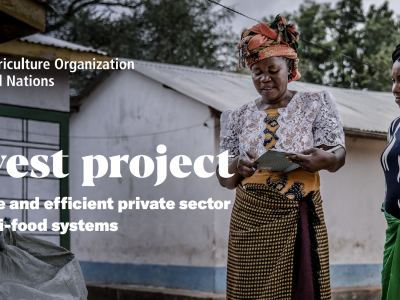
CAADP in a nutshell: Brief overview of the Comprehensive Africa Agriculture Development Programme’s rationale, principles and objectives
The Comprehensive Africa Agriculture Development Programme (CAADP) is a continent-wide agriculture initiative of the New Partnership for Africa’s Development (NEPAD), which is the strategic economic development framework of the African Union (AU). Established by the AU assembly in 2003, CAADP's goal is to eliminate hunger and reduce poverty through agriculture. To do this, African governments have agreed to increase public investment in agriculture by a minimum of 10 percent of their national budgets and raise agricultural productivity by at least 6 percent per annum. CAADP identifies four key pillars for food security improvement and agricultural investment: (1) Sustainable Land and Water Management; (2) Market Access; (3) Food Supply and Hunger; and (4) Agricultural Research.
The CAADP is centred around the definition of national and regional plans (‘Compacts’ and ‘Investment Plans’), an agreement between all stakeholders (public, private, non-state actors and development partners) serving as a framework for partnerships, alliances, and dialogue to design and implement the required policy interventions and investment programmes. The formulation of national and regional investment plans is one of the most important activities to implement CAADP after the definition and signature of the Compact. To date 30 countries in Africa have signed the national CAADP compacts, and more than 24 have reviewed investment plans. One regional CAADP compact and investment plan has been launched in West Africa, while other regions are currently making efforts to develop and launch similar compacts.
CAADP therefore is not a (donors') programme, it is a common framework for stimulating and guiding national, regional and continental initiatives on enhanced agriculture productivity and food security which each region and country can develop and implement as preferred. CAADP is the first ‘Africa led, Africa owned, Africa wide’ agriculture and food security initiative. The endorsement of CAADP by African heads of states renewed interest in and prioritized the continent’s agriculture agenda, as well as put food security objectives at the fore of national, regional, continental and even global processes. With CAADP, governments and regional economic communities (RECs) are more inclined to initiate, take ownership and commit to being responsible for their own national and regional agricultural development actions.
The process of introducing, developing, launching, implementing and eventually monitoring CAADP, holds great potential to serve as a rallying point for a wide range of stakeholders. A broad range of actors drives formulation and implementation of CAADP-related initiatives. CAADP being a continental framework, the AU, and the NEPAD Planning and Coordinating Agency (NPCA), is tasked with its coordination. RECs facilitate the formulation and implementation of a regional compact and a regional agricultural investment plan, while supporting their member states with CAADP initiatives on the national level. At the national level, governments facilitate the formulation and implementation of a national compact and investment plan. Bilateral and multilateral donors, and private sector partners with African stakeholders, to provide financial and technical support to CAADP processes and investments.
The CAADP process is organized in a way that key stakeholders meet once a year at the CAADP Partnership Platform (PP) meetings, to mutually review progress and challenges around CAADP at all levels- national, regional and continental. This is followed by a CAADP Business Meeting, half way to the next Partnership Platform meeting. In addition to these platforms, development partners who support CAADP come together through the CAADP Development Partners Task Team (DPTT), to promote dialogue, shared learning and harmonization among development partners on their support to African CAADP process and institutions. The DPTT operates on the basis of a concrete workplan and exchanges information through regular phone conference meetings.
One specific financial donor vehicle to support the CAADP processes (not investments), is the CAADP Multi-Donor Trust Fund (MTDF) hosted at the World Bank. The MDTF aims to strengthen institutional capacities of African drivers of CAADP, particularly on the continental and regional level, to effectively lead, implement, monitor and evaluate CAADP processes. Resources from the MDTF are allocated to CAADP institutions, such as the NPCA and RECs through ‘Child Trust Funds’. Financing for the investment plans could be mobilised through public sector funding, development finance, private sector partnerships and applications to the multilateral financing mechanism, the Global Agriculture and Food Security Programme (GAFSP.(1)
Traction around the regional dimension of CAADP has also gradually increased. There is widespread consensus in most African regions that the value of regional CAADP lies in strategic regional action and investments that individual countries, acting alone, cannot achieve or afford. Most stakeholders concur that regional compacts would serve to accelerate individual country agricultural growth by enabling them to benefit from regional spillovers and economies of scale in technology, human and policy development, as well as in trade and investment. Currently, processes are underway to launch compacts in IGAD, COMESA, EAC and ECCAS.
As CAADP approaches its 10-year mark, the priority for African stakeholders is to sustain the momentum, by focusing on policy and investment decisions that will help the continent transform its agriculture sector and ensure food security. The next stage of CAADP seeks to move away from the process of developing compacts towards mobilizing concrete sustainable investments for the priorities identified in the compacts(2). In this respect, and in order to strengthen the performance and competitiveness of the continent’s agriculture sector, the focus will be on increasing public sector budgets for agriculture and exploring partnerships with the private sector, beyond development finance, for countries that are now at the investment stage. At the regional level, trilateral cooperation (development partners, governments and private sector) is also seen as a way to finance cross-border agricultural development initiatives and contribute to overall regional integration and regional food security.
(For more information: www.caadp.net)
Dolly Afun-Ogidan is Policy Officer at ECDPM.
Footnotes
1. More information available at: http://www.gafspfund.org/gafsp/
2. NPCA. 2012. CAADP- Sustaining the momentum into the next decade: Implementation report. Draft report. July 2012. Midrand: NPCA
This article was published in Great Insights Volume 1, Issue 7 (September 2012)
